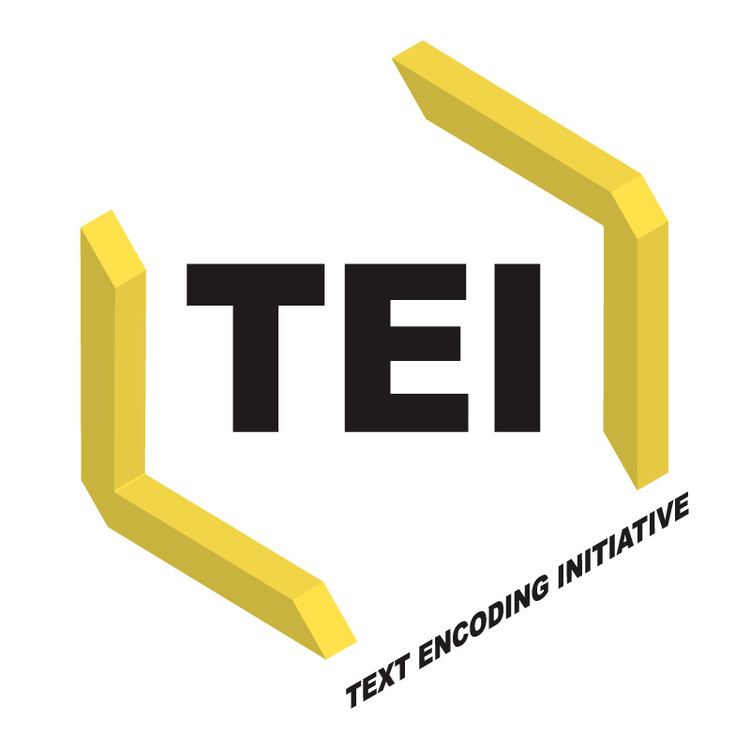 | ||
The Text Encoding Initiative (TEI) is a text-centric community of practice in the academic field of digital humanities, operating continuously since the 1980s. The community currently runs a mailing list, meetings and conference series, and maintains an eponymous technical standard, a journal, a wiki, a SourceForge repository and a toolchain.
Contents
TEI guidelines
The TEI Guidelines, which collectively define an XML format, are the defining output of the community of practice. The format differs from other well-known open formats for text (such as HTML and OpenDocument) in that it's primarily semantic rather than presentational; the semantics and interpretation of every tag and attribute are specified. Some 500 different textual components and concepts (word, sentence, character, glyph, person, etc.); each is grounded in one or more academic discipline and examples are given.
Technical details
The standard is split into two parts, a discursive textual description with extended examples and discussion and set of tag-by-tag definitions. Schemata in most of the modern formats (DTD, RELAX NG and W3C Schema) are generated automatically from the tag-by-tag definitions. A number of tools support the production of the guidelines and the application of the guidelines to specific projects.
A number of special tags are used to circumvent restrictions imposed by the underlying Unicode; glyph to allow representation of characters that don't qualify for Unicode inclusion and choice to allow overcome the required strict linearity.
Most users of the format do not use the complete range of tags but produce a customisation, using a project-specific subset of the tags and attributes defined by the Guidelines. The TEI defines a sophisticated customization mechanism known as ODD for this purpose. In addition to documenting and describing each TEI tag, an ODD specification specifies its content model and other usage constraints, which may be expressed using schematron.
TEI Lite is an example of such a customization. It defines an XML-based file format for exchanging texts. It is a manageable selection from the extensive set of elements available in the full TEI Guidelines.
Examples
The text of the TEI guidelines is rich in examples. There is also a samples page on the TEI wiki which gives examples of real-world projects which expose their underlying TEI.
Prose tags
TEI allows texts to be marked up syntactically at any level of granularity, or mixture of granularities. For example, this paragraph (p) has been marked up into sentences (s) and clauses (cl).
Verse
TEI has tags for marking up verse. This example (taken from the French translation of the TEI Guidelines) shows a sonnet
Choice tag
The choice tag is used to represent sections of text which might be encoded or tagged in more than one possible way. In the following example, based on one in the standard, choice is used twice, once to indicate an original and a corrected year and once to indicate an original and regularised spelling.
ODD
One Document Does it all ("ODD") is a literate programming language for XML schemas.
In literate-programming style, ODD documents combine human-readable documentation and machine-readable models using the Documentation Elements module of the Text Encoding Initiative. Tools generate localised and internationalised HTML, ePub, or PDF human-readable output and DTDs, W3C XML Schema, Relax NG Compact Syntax, or Relax NG XML Syntax machine-readable output.
The Roma web application is built around the ODD format and can use it to generate schemas in DTD, W3C XML Schema, Relax NG Compact Syntax, or Relax NG XML Syntax formats, as used by many XML validation tools and services.
ODD is the format used internally by the Text Encoding Initiative for their eponymous technical standard. Although ODD files generally describe the difference between a customized XML format and the full TEI model, ODD also can be used to describe XML formats that are entirely separate from the TEI. One example of this is the W3C's Internationalization Tag Set which uses the ODD format to generate schemas and document its vocabulary.
TEI customizations
TEI customizations are specializations of the TEI XML specification for use in particular fields or by specific communities.
Customization in the TEI is done through the ODD mechanism mentioned above. In truth since its P5 version, all so-called 'TEI Conformant' uses of the TEI Guidelines are based on a TEI customization documented in a TEI ODD file. Even when users choose one of the off-the-shelf pre-generated schemas to validate against, these have been created from freely available customization files.
Projects
The format is used by many projects worldwide. Practically all projects are associated with one or more universities. Some well-known projects that encode texts using TEI include:
History
Prior to the creation of TEI, humanities scholars had no common standards for encoding electronic texts in a manner which would serve their academic goals (Hockey 1993, p. 41). In 1987, a group of scholars representing fields in humanities, linguistics, and computing convened at Vassar College to put forth a set of guidelines known as the “Poughkeepsie Principles”. These guidelines directed the development of the first TEI standard, "P1"
xml:lang and xml:id attributes from the W3C (these had previously been attributes in the TEI namespace), regularization of local pointing attributes to use the hash (as used in HTML) and unification of the ptr and xptr tags. Together these changes with many more new additions make P5 more regular and bring it closer to current xml practice as promoted by the W3C and as used by other XML variants. Maintenance and feature update versions of TEI P5 have been released at least twice a year since 2007.